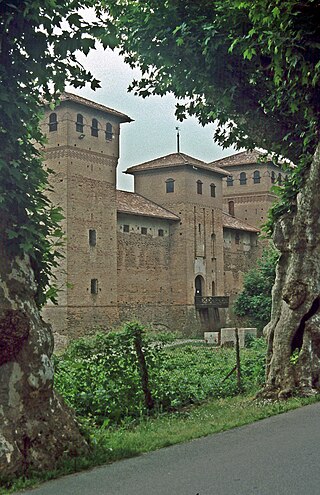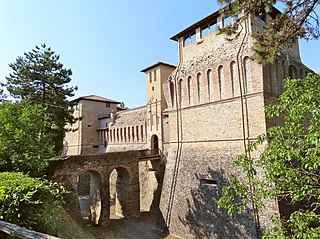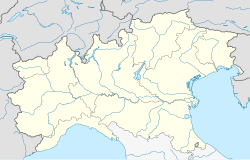
The Arda is a torrent of Emilia-Romagna, Italy, nearly all of its course being within the province of Piacenza. It is a right tributary of the Po River.

Castell'Arquato is an Italian town located on the first hills of Val D’Arda in the province of Piacenza, in Emilia-Romagna, approximately 30 kilometres (19 mi) from Piacenza and 35 kilometres (22 mi) from Parma. Places nearby include Bacedasco, Vigolo Marchese, Fiorenzuola d'Arda, Lugagnano Val d'Arda, and Vernasca. It is one of I Borghi più belli d'Italia.

Casalnoceto is a comune (municipality) in the Province of Alessandria in the Italian region Piedmont, located about 100 kilometres (62 mi) east of Turin and about 30 kilometres (19 mi) east of Alessandria.

The Rocca Sanvitale, or Sanvitale Castle, is a fortress residence in the centre of the town of Fontanellato, near Parma, northern Italy. Construction of the moated block, accessible through a drawbridge, was begun in the 13th century, mostly completed by the 15th century, with embellishments continuing through to the 18th century. It is prototypical of the urban castle-houses of the turbulent medieval communes of Northern Italy. Until the 1930s it was the home of the descendants of the Count of Sanvitale.

Vernasca is a comune (municipality) in the Province of Piacenza in the Italian region Emilia-Romagna, located about 120 kilometres (75 mi) northwest of Bologna and about 30 kilometres (19 mi) southeast of Piacenza. It is one of I Borghi più belli d'Italia.
Vigolzone is a comune (municipality) in the Province of Piacenza in the Italian region Emilia-Romagna, located about 140 kilometres (87 mi) northwest of Bologna and about 15 kilometres (9 mi) south of Piacenza.

The Val Nure is the valley of the Nure river, a tributary of the Po. The valley lies almost entirely in the Province of Piacenza, in the Emilia-Romagna region of Italy. It forms part of the Comunità Montana Valli del Nure e dell'Arda.

The Church of the Commenda is a Romanesque-style, Roman Catholic church located on Corso Europa in the Piazza Fra Sabba da Castiglione of Faenza, region of Emilia-Romagna, Italy.

Santa Maria dell'Angelo, also known as Santa Maria Nuova is a Baroque architecture, Roman Catholic church located on Via Santa Maria dell'Angelo in Faenza, region of Emilia-Romagna, Italy.

The Collegiata di Castell'Arquato, also known as the Collegiata di Santa Maria, is a Romanesque-style, Roman Catholic church located in the Castell'Arquato, province of Piacenza, in Emilia-Romagna, Italy.

Santa Maria in Castello is a Romanesque-style, Roman Catholic church located on Via di Porta Castello #35 in Tarquinia, province of Viterbo, region of Lazio, Italy.

The Visconti Castle of Binasco is a medieval castle in Binasco, Metropolitan City of Milan, Lombardy, Northern Italy. It is famous for having been the prison and execution place of Beatrice di Tenda, who was arrested and sentenced to death for adultery in 1418. Today, it is the seat of the Municipality of Binasco.

The Visconti Castle of Cherasco is a medieval castle in Cherasco, Piedmont, Northern Italy. It was built in the 14th century by Luchino Visconti, Lord of Milan, and partly reconstructed at the beginning of the 20th century.

The Visconti Castle of Vogogna is a medieval stone-made castle in Vogogna, Piedmont, Northern Italy. It was built in the 14th century by the Visconti, lords and dukes of Milan.

The Visconti Rocca of Romano is a rocca in Romano di Lombardia, Bergamo, Lombardy in Northern Italy. It was built in the 13th century and expanded in the 14th and 15th centuries by the Visconti and Colleoni families.

The Visconti Citadel of Piacenza is a fortification erected by the Visconti of Milan in the 14th century in Piacenza, Emilia-Romagna, northern Italy. In the 16th century, a new building was planned and initiated on the Citadel's site but remained uncompleted. Therefore, about half of the Citadel was not destroyed and survived until today.

The Visconti Rocca of Urgnano, also known as Visconti Castle or Albani Rocca, is a middle age fortification in Urgnano, Lombardy in northern Italy. It was built in 1354 by Giovanni Visconti, Archbishop, and Lord of Milan. Today, it is the property of the Urgnano municipality.

The Castello or Castle of Felino is a moated castle in a forested grove near the town of Felino, province of Parma, region of Emilia Romagna, Italy.

The Agazzano Castle is a fortification located in Agazzano, in province of Piacenza.





















